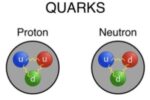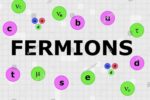Hadrons, Types, Their Properties and FAQs.
Hadrons are subatomic particles composed of quarks held together by a strong nuclear force. They include baryons (such as protons and neutrons) and mesons. Hadrons are characterized by their strong interactions and are found within atomic nuclei, playing a fundamental role in the structure of matter.
What are Hadrons?
Hadrons are subatomic particles composed of quarks held together by a strong nuclear force. They include baryons (such as protons and neutrons) and mesons. Hadrons are characterized by their strong interactions and are found within atomic nuclei, playing a fundamental role in the structure of matter.
Hadrons are sometimes referred to as Standard and Exotic Hadrons. Standard hadrons refer to the well-established and widely accepted types of hadrons, namely baryons, and mesons, whereas Exotic hadrons are a more recent and exciting area of research in particle physics. These are hypothetical or newly discovered hadrons that possess characteristics beyond the traditional quark model.
Hadrons exhibit distinct properties that are influenced by the quark flavors within them. For instance, baryons such as protons and neutrons are composed of up and down quarks, whereas mesons can be formed by combining different quark-antiquark pairs. The various combinations of quark flavors in hadrons result in differing properties such as electric charge, mass, spin etc.

Types of Hadrons;
There are two main types of hadrons are observed such as baryons and mesons.
1. Baryons: Baryons are hadrons that consist of three quarks. The most well-known baryons are protons and neutrons, which are the building blocks of atomic nuclei. Protons are composed of two up quarks and one down quark (uud), while neutrons consist of one up quark and two down quarks (udd). Baryons exhibit a half-integer spin due to the combination of spins of their constituent quarks.
Other examples of baryons include the lambda baryon (Λ), sigma baryons (Σ), and xi baryons (Ξ). These particles contain various combinations of up, down, strange, charm, and bottom quarks. Baryons are fermions and interact via the strong nuclear force.
2. Mesons: Mesons are hadrons that consist of a quark and an antiquark pair. They have a quark-antiquark structure, such as up-antidown (ūd), charm-antistrange (c̄s), or strange-antistrange (s̄s). Mesons are bosons and have integer spins.
The pion (π) is the most well-known meson and plays a crucial role in mediating the strong force between nucleons. It consists of an up quark and an anti-down quark (ūd). Other mesons include the kaon (K), consisting of strange and antidown or antiup quarks, and the J/ψ meson, consisting of charm and anticharm quarks.
Mesons are unstable and have relatively short lifetimes compared to baryons. Their existence is crucial in understanding the behavior of the strong nuclear force and the behavior of quarks within hadrons.
It’s worth noting that there are many more baryons and mesons beyond the examples mentioned here. The study of hadrons and their properties is an active area of research in particle physics, with ongoing efforts to discover and understand the properties of new and exotic hadrons.
Properties of Hadrons;
1. Electric Charge: Hadrons can carry electric charge due to the combination of charges carried by their constituent quarks. The electric charge of a hadron is given by the sum of the charges of its quarks. For example, the proton has a charge of +1, while the neutron has no electric charge (charge 0).
2. Mass: The mass of a hadron is determined by the masses of its constituent quarks and the binding energy that holds them together. Quarks have relatively small masses, and the majority of the mass of a hadron comes from the strong interaction energy. Different combinations of quark flavors result in hadrons with different masses. For instance, protons and neutrons have similar masses, around 938 million electron volts (MeV/c²), while mesons have masses that vary depending on their quark composition.
3. Spin: Hadrons have intrinsic angular momentum called spin, which is a fundamental property of elementary particles. The spin of a hadron is determined by the combination of spins of its constituent quarks. Baryons, which are made up of three quarks, have half-integer spin values such as 1/2, 3/2, etc., while mesons, consisting of a quark-antiquark pair, have integer spin values such as 0, 1, etc. Spin influences the behavior of hadrons in interactions and affects their stability.
4. Isospin: Isospin is a quantum number that describes a symmetry between up-type quarks (up, charm, and top) and down-type quarks (down, strange, and bottom). Isospin is analogous to the concept of electric charge and helps explain similarities and differences between different flavors of quarks. Hadrons can have specific isospin values based on the isospin of their constituent quarks.
5. Flavor: Flavor is a property associated with quarks and determines the type or variety of quarks within a hadron. The six known quark flavors are up, down, charm, strange, top, and bottom. Different combinations of quark flavors create different hadrons with varying properties. For example, protons consist of two up quarks and one down quark, while pions consist of an up quark and an antidown quark.
6. Lifetime: Hadrons have different lifetimes, which can range from extremely short-lived to relatively stable. The stability of a hadron depends on factors such as its quark composition and the interactions involved. Baryons, composed of three quarks, tend to be more stable than mesons, which are quark-antiquark pairs. Some hadrons, particularly those with heavier quark flavors, have shorter lifetimes and are more prone to decay.
7. Strong Interaction: Hadrons are primarily influenced by the strong nuclear force, also known as the strong interaction. This force binds quarks together within hadrons and is responsible for the overall structure and stability of these particles. Strong interaction is one of the fundamental forces of nature and plays a crucial role in particle physics and the behavior of atomic nuclei.
Understanding the properties of hadrons is essential for comprehending the structure of matter, the behavior of quarks, and the fundamental forces governing the universe.
FAQs of Hadrons;
Q: What are hadrons?
A: Hadrons are subatomic particles composed of quarks, which are elementary particles. They are categorized into two main types: baryons (composed of three quarks) and mesons (composed of a quark-antiquark pair).
Q: What are the main properties of hadrons?
A: The properties of hadrons include electric charge, mass, and spin. These properties are determined by the combination of quark flavors within the hadron and the interactions governed by the strong nuclear force.
Q: What is the strong nuclear force?
A: The strong nuclear force, also known as the strong interaction, is one of the fundamental forces in nature. It is responsible for holding quarks together within hadrons and is responsible for the stability and properties of atomic nuclei.
Q: What are the quark flavors?
A: The known quark flavors are up (u), down (d), charm (c), strange (s), top (t), and bottom (b). Each quark flavor possesses a specific electric charge and mass, and their combinations give rise to the different types of hadrons.
Q: How do the quark flavors determine the properties of hadrons?
A: The combinations of quark flavors within hadrons determine their electric charge, mass, and spin. Different combinations result in different properties and behaviors of the hadrons.
Q: What are some examples of baryons?
A: Examples of baryons include protons (uud) and neutrons (udd), which are the most common building blocks of atomic nuclei. Other examples include lambda baryons (Λ), sigma baryons (Σ), and xi baryons (Ξ), which consist of various combinations of quark flavors.
Q: What are some examples of mesons?
A: Examples of mesons include pions (π), kaons (K), and J/ψ mesons, which are composed of different quark-antiquark pairs such as ūd, s̄d, or c̄c. Pions, in particular, play a crucial role in mediating the strong force between nucleons.
Q: How are hadrons detected and studied?
A: Hadrons are detected and studied through experiments conducted in particle accelerators. These experiments involve colliding particles at high energies and analyzing the resulting particle interactions and decay patterns using detectors and sophisticated analysis techniques.
Q: Are there any exotic or unusual hadrons?
A: Yes, there are ongoing efforts to discover and understand exotic or unusual hadrons. These may include hadrons composed of more than three quarks (known as pentaquarks or tetraquarks) or hadrons with quarks of heavier flavors. The study of such particles contributes to our understanding of the fundamental structure of matter.
Q: What is the significance of studying hadrons?
A: Studying hadrons provides insights into the strong nuclear force, the behavior of quarks, and the structure of matter. It contributes to our understanding of the fundamental forces and particles that make up the universe and has implications for fields such as particle physics, nuclear physics, and astrophysics.
Conclusion;
Hadrons are subatomic particles that are composed of quarks, which are elementary particles. They are categorized into two main types: baryons and mesons. Baryons consist of three quarks, whereas mesons consist of a quark-antiquark pair. The behavior and properties of hadrons are dictated by the strong nuclear force, also known as the strong interaction, which is one of the four fundamental forces in nature.



2 Comments
[…] modes and rates depend on the type of Xi particle. When Xi baryons decay, they transform into other hadrons (baryons or mesons) through the exchange of gluons between […]
[…] Science, physics FAQs of quarks, flavors of quarks, properties of quarks Previous PostWhat are Leptons; Know Types, Properties and FAQs.Next PostHadrons, Types, Their Properties and FAQs. […]